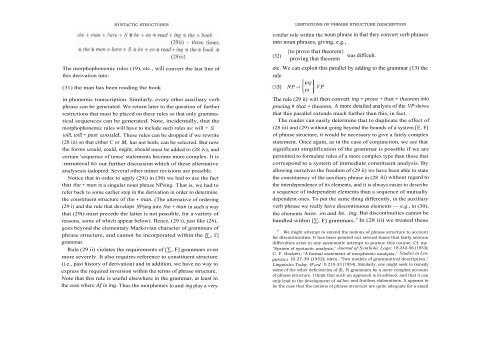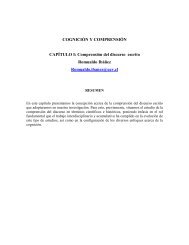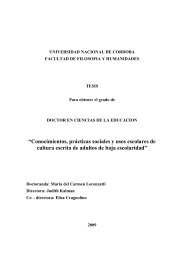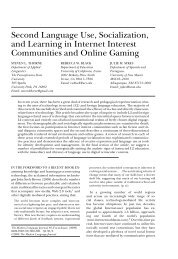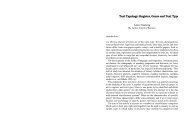Syntactic Structures
Syntactic Structures
Syntactic Structures
You also want an ePaper? Increase the reach of your titles
YUMPU automatically turns print PDFs into web optimized ePapers that Google loves.
SYNTACTIC STRUCTURES<br />
The morphophonemic rules (19), etc., will convert the last line of<br />
this derivation into:<br />
(31) the man has been reading the book<br />
in phonemic transcription. Similarly, every other auxiliary verb<br />
phrase can be generated. We return later to the question of further<br />
restrictions that must be placed on these rules so that only grammatical<br />
sequences can be generated. Note, incidentally, that the<br />
morphophonemic rules will have to include such rules as: will + S<br />
will, will + past would. These rules can be dropped if we rewrite<br />
(28 iii) so that either C or M, hut not both, can be selected. But now<br />
the forms would, could, might, should must be added to (28 iv), and<br />
certain 'sequence of tense' statements become more complex. It is<br />
i mmateral to our further discussion which of these alternative<br />
analysesis iadopted. Several other minor revisions are possible.<br />
Notice that in order to apply (29i) in (30) we had to use the fact<br />
that the + man is a singular noun phrase NPsing. That is, we had to<br />
refer back to some earlier step in the derivation in order to determine<br />
the constituent structure of the + man. (The alternative of ordering<br />
(29 i) and the rule that develops NPsing into the + man in such a way<br />
that (29i) must precede the latter is not possible, for a variety of<br />
reasons, some of which appear below). Hence, (29 i), just like (26),<br />
goes beyond the elementary Markovian character of grammars of<br />
phrase structure, and cannot be incorporated within the [∑, F]<br />
grammar.<br />
Rule (29 ii) violates the requirements of [∑, F] grammars even<br />
more severely. It also requires reference to constituent structure<br />
(i.e., past history of derivation) and in addition, we have no way to<br />
express the required inversion within the terms of phrase structure.<br />
Note that this rule is useful elsewhere in the grammar, at least in<br />
the case where Af is ing. Thus the morphemes to and ing play a very<br />
LIMITATIONS OF PHRASE STRUCTURE DESCRIPTION<br />
similar role within the noun phrase in that they convert verb phrases<br />
into noun phrases, giving, e.g.,<br />
{to prove that theorem}<br />
(32) was difficult.<br />
proving that theorem<br />
etc. We can exploit this parallel by adding to the grammar (13) the<br />
rule<br />
The rule (29 ii) will then convert ing + prove + that + theorem into<br />
proving # that + theorem. A more detailed analysis of the VP shows<br />
that this parallel extends much further than this, in fact.<br />
The reader can easily determine that to duplicate the effect of<br />
(28 iii) and (29) without going beyond the bounds of a system [E, F]<br />
of phrase structure, it would be necessary to give a fairly complex<br />
statement. Once again, as in the case of conjunction, we see that<br />
significant simplification of the grammar is possible if we are<br />
permitted to formulate rules of a more complex type than those that<br />
correspond to a system of immediate constituent analysis. By<br />
allowing ourselves the freedom of (29 ii) we have been able to state<br />
the constituency of the auxiliary phrase in (28 iii) without regard to<br />
the interdependence of its elements, and it is always easier to describe<br />
a sequence of independent elements than a sequence of mutually<br />
dependent ones. To put the same thing differently, in the auxiliary<br />
verb phrase we really have discontinuous elements — e.g., in (30),<br />
the elements have. .en and be. .ing. But discontinuities cannot be<br />
handled within [∑, F] grammars. 6 In (28 iii) we treated these<br />
6 We might attempt to extend the notions of phrase structure to account<br />
for discontinuities. It has been pointed out several times that fairly serious<br />
difficulties arise in any systematic attempt to pursue this course. Cf. my<br />
"System of syntactic analysis," Journal of Symbolic Logic 18.242-56 (1953);<br />
C. F. Hockett, "A formal statement of morphemic analysis," Studies in Linguistics<br />
10.27-39 (1952); idem, "Two models of grammatical description,"<br />
Linguistics Today, Word 1 0.210-33 (1954). Similarly, one might seek to remedy<br />
some of the other deficiencies of [E, F] grammars by a more complex account<br />
of phrase structure. I think that such an approach is ill-advised, and that it can<br />
only lead to the development of ad hoc and fruitless elaborations. It appears to<br />
be the case that the notions of phrase structure are quite adequate for a small


